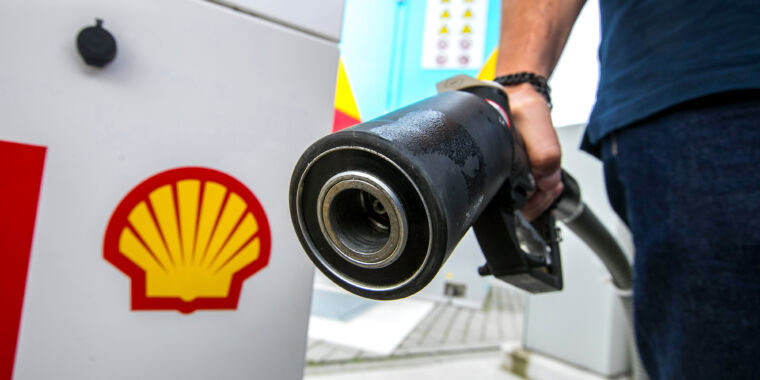Krisztian Bocsi/Bloomberg via Getty Images
Shell has closed all seven of its retail hydrogen filling stations in California, according to Hydrogen Insight. Now, the energy company will just operate a trio of hydrogen stations for heavy-duty vehicles like class 8 drayage trucks or garbage trucks. It’s further confirmation that while hydrogen has a role as a clean fuel for transportation, that will not involve passenger cars, at least not any time soon.
Shell piloted its first California retail hydrogen station in a 2008 pilot program in Los Angeles. In 2011, it built its first pipeline-fed hydrogen station in Torrance—conveniently near Toyota’s then-HQ. Six years later, Shell revealed plans for more hydrogen stations in the state, funded in part by grants from the California Energy Commission.
Things started to look a bit more ambitious with “Project Neptune,” which would see Shell build out 48 new hydrogen stations in California and upgrade a pair of existing sites. Toyota, Honda, and Hyundai all agreed to help fund the project, which also obtained a $40 million, five-year grant from the CEC.
Despite that funding, in late 2023, it announced that “Shell has discontinued its plan to build and operate additional light-duty vehicle fueling stations in California. That year, Shell also closed five of its seven retail hydrogen stations temporarily; now, it is permanently closing all seven of the stations that just serve light vehicles.
These closures will leave California with fewer than 50 public hydrogen filling stations; by contrast, the state has 2,045 public DC fast-charging sites for electric vehicles, with almost 11,000 charging ports. (Indeed, even as Shell canceled its retail hydrogen plans, it was expanding its EV charging network with the acquisition of Volta last March.)
-
This Shell station in Torrance, Calif., was the first in the country to be fed directly from an active industrial hydrogen pipeline.
Tim Rue/Bloomberg via Getty Images -
A map of California’s retail hydrogen fueling stations.
-
Here are the hydrogen fueling stations for heavy-duty vehicles.
Hydrogen still has its uses
At this point, it seems quite clear that hydrogen’s future as a fuel for light vehicles—passenger cars like the Toyota Mirai or SUVs like the Hyundai Nexo—is done and dusted.
Even before the Biden administration’s Infrastructure Investment and Jobs Act started to infuse significant federal funds into the problem, EV charging infrastructure was orders of magnitude more robust than hydrogen’s, which remained confined to California. And with no real infrastructure to speak of, most automakers have barely bothered with hydrogen fuel cell cars and SUVs.
But it’s also becoming increasingly clear that hydrogen does have a future in decarbonizing transportation. Battery EVs have made significant strides in the past decade and a half for light vehicles, but as you scale up to heavy-duty vehicles, they start to make less sense because battery weight begins to have a deleterious effect on the payload. Here, hydrogen fuel cell trucks have an advantage.
“Most battery trucks on the market are 3,000 to 6,000 pounds [1,361–2,721 kg] heavier than us. And so it’s a material revenue and profitability difference when you’re talking about hauling with our truck versus a battery truck,” said Parker Meeks, CEO at Hyzon Motors. The company recently delivered Performance Food Group its four hydrogen fuel cell class 8 trucks, the start of a pilot with the food distributor that currently operates a nationwide fleet of 7,000 trucks.

Hyzon Motors
Those first four trucks use Hyzon’s current class 8 fuel cell powertrain, which combines a 110 kW fuel cell with a 110 kWh lithium titanate battery. Assuming all goes well with these initial trucks and testing of Hyzon’s new 200 kW power cell, PFG may acquire as many as 45 of the more powerful machines.
“Whenever you look at our pipeline, the number of fleets we have and each stage of development, we are prescreening fleets. Not every place is just like PFG, but this is the profile: back to base nature of operations, large warehouse, trapped demand for fueling infrastructure,” Meeks explained.
Hyzon also just signed a joint development agreement with New Way Trucks to develop fuel cell garbage trucks for the North American market, having already piloted the approach in Australia. “The payload penalty for a battery garbage truck is almost 50 percent,” Meeks explained.
Predictable routes, like those operated by drayage trucks, delivery trucks from distribution warehouses, or garbage trucks, mean you can sensibly plan where to place hydrogen infrastructure. After all, there’s no need for a station every few miles if you know you’ll always return to base and refuel at the end of the day.
“Most of these fleets have diesel white hose overnight service, meaning a diesel truck comes in and they pump the hose and refuel all the trucks overnight. So for the operators, their primary fueling method is not truck stops. Which actually is good for all of us. They want on-premise dispensing,” Meeks told me.




